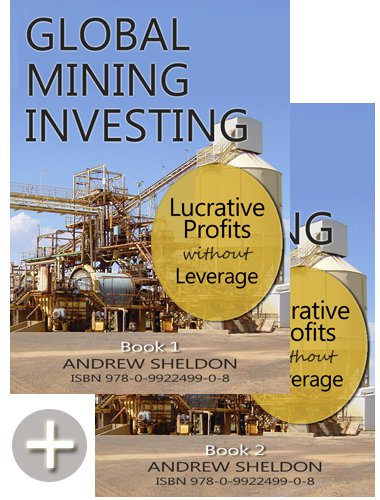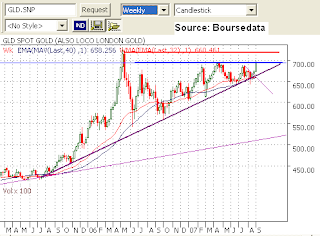 Global Mining Investing $69.95, 2 Volume e-Book Set. Buy here.
Global Mining Investing $69.95, 2 Volume e-Book Set. Buy here.Author, Andrew Sheldon
Global Mining Investing is a reference eBook to teach investors how to think and act as investors with a underlying theme of managing risk. The book touches on a huge amount of content which heavily relies on knowledge that can only be obtained through experience...The text was engaging, as I knew the valuable outcome was to be a better thinker and investor.
While some books (such as Coulson’s An Insider’s Guide to the Mining Sector) focus on one particular commodity this book (Global Mining Investing) attempts (and does well) to cover all types of mining and commodities.
Global Mining Investing - see store
Saturday, September 29, 2007
Opportune time for agricultural commodities
Friday, September 28, 2007
Gold breaking out! Confirmed
The break is convincing in several respects:
1. Gold broke the previous high of $730.30 set on the 8th May'06.
2. The gold price rally was convincing in itself - up $9.75/oz
3. The gold price closed near its daily high
4. The gold price move is supported by strong fundamentals

But if we look at the following chart we can see that the current rally in the gold price is partially due to gold fundamentals (in as much as the gold price is rising in terms of all currencies) and partly due to a weaker USD (in as much as the USD denominated gold price has risen more). Of course what we would like to see is the gold price break out in Euro & Pound terms, as well as Yen and AUD.

A real increase in the gold price in terms of multiple currencies communicates a growing distrust of monetary units. The reason for this distrust is the relative decline in the valu of those currencies. Currencies decline in value in real terms because the amount of currency in circulation is growing faster than the productive capacity of the global economy. You might think this is a signal to buy other tangible or physical assets as well, but actually this is not the case because their prices are already too high. Most asset markets are high priced because in a period of prolonged monetary expansion, those assets become priced (not on the basis of cost + profit margin) but your ability to pay and your belief in the sustainability of those high prices. The consequence is thus, asset prices are too high, and they will only offer gold buying when interest rates have risen to an extent that property holdings have been deleveraged. You might ask what level of deleveraging has to occur. Well that depends on each country's monetary expansion over the last 20 years less the amount of productive capacity added. Those countries like Australia which have huge exposure to metals are more vulnerable, even though they are helped by gold mining capacity.
You might ask 'why gold' since it is an asset? Well the reason is that gold has under-performed as an asset class over the last 5 years compared to other assets. The reason that it has under-performed is because it offers a low return - assuming you lease the metal, and none if you dont. Its this criticism of gold that makes it the most attractive investment, along with other precious metals. But gold is the best at this stage of the cycle because other precious metals will suffer eventually from a 'demand shock' as higher interest rates curtail industrial demand for commodities.
But gold is a financial asset as well, and as such, its possible for companies to leverage themselves into gold, so prices will in times of uncertainty be volatile. Financial intermediaries will be inclined to sell gold to cover other loss-making positions. But gold will recover like no other financial instrument - at least until the market is deleveraged. In times of instability markets tend to over-react.
Over the last 20 years western governments have been competing in a money expansion fest. Rising inflation will undermine that. Governments can conceal inflation, but they can't conceal the financial burden that places on 'real' people, so there will be a backlash. Higher gold prices will raise attention to this fact. Why is gold over $400/oz if not inflation? Afterall it offers bugger all return. The reason is - its real money when fiat paper is not trusted. The other sign of high inflation is wages...and with falling housing prices, reseting interest rates, tight labour markets, we can expect higher rates.
Wednesday, September 26, 2007
Source of Base Metal Charts
The historical charts can be accessed at:
1. Copper: See www.kitcometals.com/charts/copper_historical.html
2. Zinc: See www.kitcometals.com/charts/zinc_historical.html
3. Nickel: www.kitcometals.com/charts/nickel_historical.html
4. Lead: www.kitcometals.com/charts/lead_historical.html
5. Aluminium: See www.kitcometals.com/charts/aluminum_historical.html
6. Tin: See ???
In the precious metals we have
7. Gold: See www.kitco.com/charts/techcharts_gold.html
8. Silver: See www.kitco.com/charts/techcharts_silver.html
9. Palladium: See www.kitco.com/charts/techcharts_palladium.html
10. Platinum: See www.kitco.com/charts/techcharts_platinum.html
11. Rhodium: See www.kitco.com/charts/historicalrhodium.html
These are the traded metals where there is a high level of price discovery or disclosure. There are of course alot of other where price information is not so transparent because these metals prices are concealed by confidential commercial agreements between producers and end users. The reason for this is that these markets are illiquid. Another problem is that the metals are often sold as ores or metal concentrates with widely variable concentrations, as well as price bonuses (for precious by-products) and penalties (for deleterious contaminants). For this reason its difficult to reach a standard price for these commodities because every refinery has a different pricing policy to achieve competitive advantage. These metals include:
12. Zircon:
13: Niobium:
14. Tantalum: See www.metalprices.com/FreeSite/Charts/tantalite_charts.html?weight=lb (before 2006) and http://metalsplace.com/prices/?a=14&grt=6 since.
15. Molybdenum: See www.adanacmoly.com/adanac_stock.php
16. Manganese: See www.metalprices.com/FreeSite/Charts/mn_ferro_charts.html?weight=lb (before 2006)
17. Cobalt: See ??
18. Magnesium: See http://metalsplace.com/prices/
19. Chrome: See ??
20. Antimony: See ??
21: Bismuth: See ??
22. Tungsten: See http://metalsplace.com/prices/?a=4&grt=5
23. Mercury: See ??
24. Vanadium: See ??
25. Cadmium: see www.asianmetal.com/Metal_News/index_product63_en.asp or http://metalsplace.com/prices/?a=15&grt=6
26. Iron ore: See http://metalsplace.com/prices/
No other metal not listed here is sold as a discrete commodity because they dont occur in isolation. Even some of the commodities above are seldom mined as a discrete commodity. eg. Cobalt is usually a by-product of nickel mining, bismuth is often a by-product of tin mining, antimony is often associated with gold. These metal combinations might simply be liberated by physical crushing, but often they require more expensive chemical separation processes that directly impact on the value of ores, thus making price determination less transparent.
Finally we have the energy-based commodities:
25. Petroleum:
26. Natural Gas:
27. Uranium (yellowcake): See www.uxc.com/review/uxc_g_price.html or in constant dollar terms www.uxc.com/review/uxc_g_hist-price.html
28. Thorium: See http://minerals.usgs.gov/minerals/pubs/metal_prices/
Otherwise you can perform price queries at this site: www.metalprices.com/freesite/historical/price-query.asp. See the US Geological Survey for more more info on commodities: http://minerals.usgs.gov/minerals/pubs/metal_prices and www.crbtrader.com/fund/articles/default.asp. Here are a few other places for metal price charts - http://www.mineralstox.com/.
Friday, September 21, 2007
Gold testing resistance at $US730/oz
Thursday, September 06, 2007
Gold breaking out!

The rationale for not yet investing in gold (stocks) was that I perceived a possibility of short term weakness in gold as a result of investment fund selling, as they raced to cover positions, so wanted to wait mostly on the sides until the confirmation came today. Clearly the market believes the US government and Fed are going to support the credit market, or that it will otherwise save itself. Regardless I will support the trend as long as it persists. See A Speculators Dream to see which ASX stocks I'm holding.
Sunday, September 02, 2007
Gold - Trend confirmation imminent
1. Bush is offering creditors support if they have a good credit history - to his credit its better targeted support than the central bank flooding the banking system with liquidity
2. Bernacke providing the market with at least the 'hope' of a rate cut. Its my personal opinion that if he was going to offer a rate cut - it would have come 2 weeks ago.
So the choir singing was a surprise - but it comes no surprise that the performance was out of tune. Am I starting to sound like a nervous central banker. Well, just to offer some technical support to this premise:
1. The gold market rallied $8/oz on the news of the Bush-Bernacke support
2. Bush at least seems to be conveying the message that the US government and Fed are on the same ball team by speaking on the same day (Friday)
The bad news for markets:
1. The Dow has not broken resistance - see Market Commentary
2. The gold price has not broken its previous high. Instead it was sold off from $675/oz to $672.
So I think its premature to take a position in the precious metals market or stocks. At this point I see all markets being sold off - but the precious metals market will eventually shine.
 Global Mining Investing $69.95, 2 Volume e-Book Set.
Global Mining Investing $69.95, 2 Volume e-Book Set.Author, Andrew Sheldon
Global Mining Investing is a reference eBook to teach investors how to think and act as investors with a underlying theme of managing risk. The book touches on a huge amount of content which heavily relies on knowledge that can only be obtained through experience...The text was engaging, as I knew the valuable outcome was to be a better thinker and investor.
While some books (such as Coulson’s An Insider’s Guide to the Mining Sector) focus on one particular commodity this book (Global Mining Investing) attempts (and does well) to cover all types of mining and commodities.
Global Mining Investing - see store
Japan Foreclosed Property 2015-2016 - Buy this 5th edition report!
You can view foreclosed properties listed for as little as $US10,000 in Japan thanks to depopulation and a culture that is geared towards working for the state. I bought foreclosed properties in Japan and now I reveal all in our expanded 350+page report. The information you need to know, strategies to apply, where to get help, and the tools to use. We even help you avoid the tsunami and nuclear risks since I was a geologist/mining finance analyst in a past life. Check out the "feedback" in our blog for stories of success by customers of our previous reports.
Download Table of Contents here.







![[Most Recent Quotes from www.kitco.com]](http://www.kitconet.com/charts/metals/gold/t24_au_en_usoz_2.gif)
![[Most Recent Quotes from www.kitco.com]](http://www.kitconet.com/charts/metals/silver/t24_ag_en_usoz_2.gif)
![[Most Recent Quotes from www.kitco.com]](http://www.kitconet.com/charts/metals/platinum/t24_pt_en_uskg_2.gif)
![[Most Recent Quotes from www.kitco.com]](http://www.kitconet.com/charts/metals/palladium/t24_pd_en_usoz_2.gif)